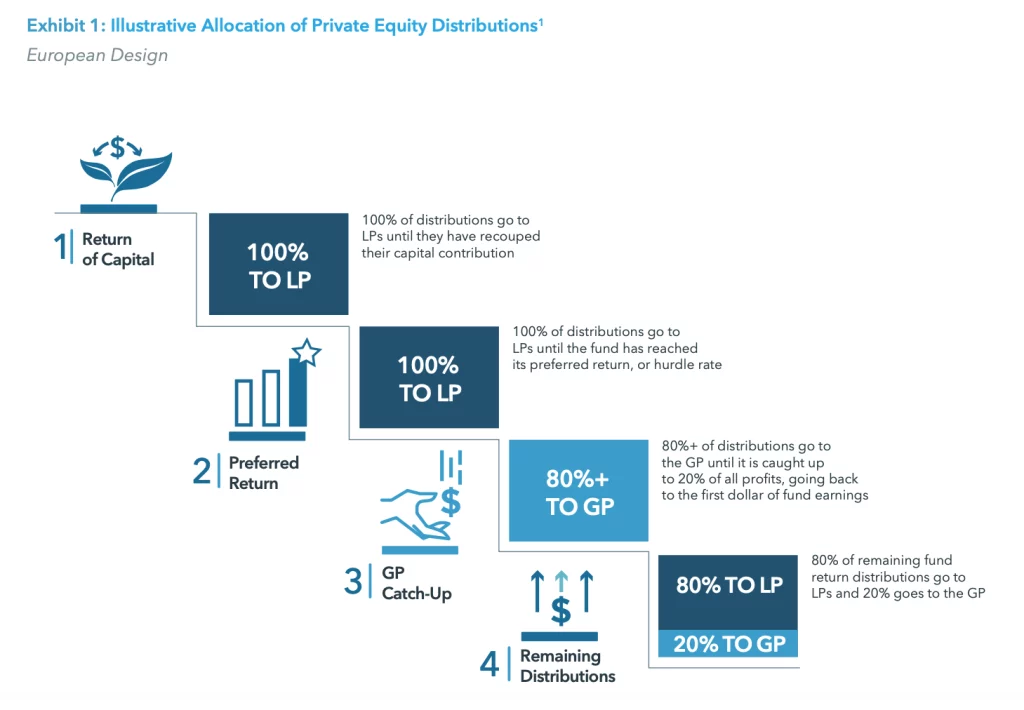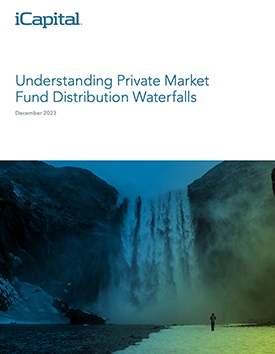One of the more compelling value propositions of the private markets industry is the strong alignment of interests between general partners (GPs) who manage funds and limited partners (LPs) who invest. A key driver of this alignment is carried interest, or the performance-based incentive fee that GPs collect, which typically represents 10–20% of profits generated by a fund after a preferred return is achieved. Unlike other asset classes, where managers may only collect fees as a percentage of assets under management, private market fund managers have an added incentive to deliver strong performance, rather than simply gather assets.
Most private market funds set their hurdle rate or preferred return at around 8%, though this may vary depending on the fund’s strategy. This means the fund manager must generate an annualized net return of at least 8% for investors before the manager can share in any of the fund’s profits. The preferred return is a critical tool to ensure that managers achieve a prespecified baseline return for investors before they can collect incentive compensation.
However, it is important for investors to properly assess a private market fund’s waterfall (the allocation of distributions between the GP and LPs) in order to ensure proper alignment of interests. There are four primary components to one of the most common forms of distribution waterfalls; the European waterfall.
1. RETURN OF CAPITAL
100% of a fund’s proceeds are distributed to investors until they have received an amount equal to the total amount they have invested.
2. PREFERRED RETURN
Investors continue to receive 100% of fund proceeds until the fund has achieved its preferred return, or hurdle rate, as defined in the fund’s offering documents. While the typical preferred return in private equity is 8%, it is often 6–7% in the case of private credit funds, which usually have lower target returns than buyout funds. Note that venture capital funds do not typically offer a preferred return.
3. GP CATCH-UP
Once a fund has returned all contributions to investors and reached its preferred return, the GP is then able to begin collecting carried interest, which is calculated by going back to the first dollar of profits generated by the fund. In order to recoup the GP’s share of returns accrued prior to reaching the hurdle rate, most funds have a GP catch- up provision, which allows a manager to retain a higher proportional amount of a fund’s profits (ranging from 50–100%) until it has caught up to the profit percentage to which it is entitled (generally ranging from 10–20%). For example, once the fund reaches its hurdle rate, 50–100% of the next distributions will be allocated to the GP until its return equals the prespecified share of profits.
4. REMAINING DISTRIBUTIONS
After the manager is caught up and has received its prespecified share of profits for fund distributions made to investors, all remaining proceeds are then allocated between LPs and the GP at the specified rate (typically ranging from 80–90% to LPs and 10–20% to the GP, depending on the terms of the fund).
A well-designed waterfall can be a benefit for LPs, as it creates strong alignment and properly incentivizes the manager to optimize returns.
While these four components are relatively standard across most private market funds, there are variations on how a GP may implement its waterfall. The most common variations are the European waterfall and the American waterfall. The designation of European vs. American refers to the way that the waterfall is structured, not the geographical location of the manager. Under a European waterfall structure (previously described), carried interest is calculated at the fund level across all deals. In this scenario, the GP does not begin to take carried interest until the fund has returned all LP contributions across all deals and delivered the preferred return.
By contrast, an American waterfall is calculated on a deal-by-deal basis, and a GP is compensated for each successful deal. This often allows the GP to begin taking a share of the profits, or carried interest, earlier in the life of a fund. In some cases, this can alter a GP’s behavior, as collecting carried interest on a few large, successful deals early on may reduce their incentive to optimize performance later in a fund’s life. An American waterfall also can result in a GP receiving carried interest on a fund that is underperforming its hurdle rate, provided that there are individual deals that have outperformed the preferred return. Almost all funds that utilize an American waterfall include a clawback provision, which require GPs to hold a portion of carried interest collected over the life of the fund in escrow to account for scenarios under which the overall performance of the fully liquidated fund dips below the hurdle rate. This allows for the recovery of any excess carried interest that the GP may have retained to ensure that LPs receive their net hurdle rate. European waterfalls are generally more favorable for investors because they delay the payment of carried interest and prevent GPs from collecting incentive compensation on funds that underperform.
EUROPEAN WATERFALL: Performance is measured versus the hurdle rate at the fund level.
AMERICAN WATERFALL: Performance is measured versus the hurdle rate on a deal-by-deal basis.
Due to the somewhat complex nature of waterfalls, investors should carefully examine a fund’s terms to understand how carried interest is paid.
It is important that the waterfall structure is designed to appropriately balance the needs of both the investor and the manager to maximize the alignment of interests between all parties involved. A well-designed waterfall can be a benefit for LPs, as it creates strong alignment and properly incentivizes the manager to optimize returns. When a fund is performing well, fund managers reap the benefits along with their investors.
(1) For illustrative purposes only. Example of a private markets fund with 20% carried interest and a catch-up rate of 80%. Terms and percentages may vary by fund.
IMPORTANT INFORMATION
The material herein has been provided to you for informational purposes only by Institutional Capital Network, Inc. (“iCapital Network”) or one of its affiliates (iCapital Network together with its affiliates, “iCapital”). This material is the property of iCapital and may not be shared without the written permission of iCapital. No part of this material may be reproduced in any form, or referred to in any other publication, without express written permission of iCapital.
This material is provided for informational purposes only and is not intended as, and may not be relied on in any manner as, legal, tax or investment advice, a recommendation, or as an offer or solicitation to buy or sell any security, financial product or instrument, or otherwise to participate in any particular trading strategy. This material does not intend to address the financial objectives, situation, or specific needs of any individual investor. You should consult your personal accounting, tax and legal advisors to understand the implications of any investment specific to your personal financial situation.
ALTERNATIVE INVESTMENTS ARE CONSIDERED COMPLEX PRODUCTS AND MAY NOT BE SUITABLE FOR ALL INVESTORS. Prospective investors should be aware that an investment in an alternative investment is speculative and involves a high degree of risk. Alternative Investments often engage in leveraging and other speculative investment practices that may increase the risk of investment loss; can be highly illiquid; may not be required to provide periodic pricing or valuation information to investors; may involve complex tax structures and delays in distributing important tax information; are not subject to the same regulatory requirements as mutual funds; and often charge high fees. There is no guarantee that an alternative investment will implement its investment strategy and/or achieve its objectives, generate profits, or avoid loss. An investment should only be considered by sophisticated investors who can afford to lose all or a substantial amount of their investment.
iCapital Markets LLC operates a platform that makes available financial products to financial professionals. In operating this platform, iCapital Markets LLC generally earns revenue based on the volume of transactions that take place in these products and would benefit by an increase in sales for these products.
The information contained herein is an opinion only, as of the date indicated, and should not be relied upon as the only important information available. Any prediction, projection or forecast on the economy, stock market, bond market or the economic trends of the markets is not necessarily indicative of the future or likely performance. The information contained herein is subject to change, incomplete, and may include information and/or data obtained from third party sources that iCapital believes, but does not guarantee, to be accurate. iCapital considers this third-party data reliable, but does not represent that it is accurate, complete and/or up to date, and it should not be relied on as such. iCapital makes no representation as to the accuracy or completeness of this material and accepts no liability for losses arising from the use of the material presented. No representation or warranty is made by iCapital as to the reasonableness or completeness of such forward-looking statements or to any other financial information contained herein.
Securities products and services are offered by iCapital Markets, an SEC-registered broker-dealer, member FINRA and SIPC, and an affiliate of iCapital, Inc. and Institutional Capital Network, Inc. These registrations and memberships in no way imply that the SEC, FINRA, or SIPC have endorsed any of the entities, products, or services discussed herein. Annuities and insurance services are provided by iCapital Annuities and Insurance Services LLC, an affiliate of iCapital, Inc. “iCapital” and “iCapital Network” are registered trademarks of Institutional Capital Network, Inc. Additional information is available upon request.
©2024 Institutional Capital Network, Inc. All Rights Reserved. | 2024.01



















